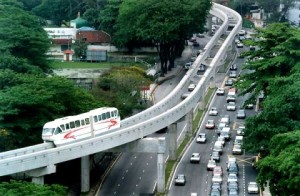Chennai Monorail
Chennai is going full steam ahead and this time it seems like the government is pulling out all the stops to make the growth story even bigger and better than ever before. Recently ranked 9th in the list of the world’s best cosmopolitan cities the Tamil Nadu Government has given the infrastructure a much needed boost by re-introducing the monorail project.
The monorail project was initiated in order to reduce traffic congestion and to increase the share of public transport in the urban transport network. Typically, Chennai has always faced severe traffic problems due to inadequate, shrunken and encroached footpaths and several key missing links in terms of road connectivity. With substantial increase in the population and the introduction of more bus facilities and goods vehicles the traffic situation has worsened even further. Given this scenario, the Monorail project is often cited as a whiff of fresh air in a choc-a-bloc city. It aims to reduce traffic congestion, road accidents and improve mobility for pedestrians besides providing an affordable and safe mode of travel for everyone.
How it Works
A monorail, in simple terms, is an electric-powered bus that runs on an elevated concrete beam. This system is often confused with light rail systems such as cable cars and tramways. In terms of commercial viability, this system has been highly successful world over and many densely populated countries have adopted this system for its long term benefits.
In India, around the start of 2014, with the successful launch of the monorail project in Mumbai, cities such as Thiruvananthapuram, Kozhikode and Delhi are pursuing monorail projects as well.
Is it commercially on track?
In Chennai, the government invited bids for the ambitious ‘Elevated Monorail Mass Rapid Transit System’ (EMMRTS), Monorail project covering over 300 kms. to be implemented in a single phase. Spanning 18 corridors, this project, when executed, would turn out to the biggest monorail project in the world. (There are fewer than 20 monorail systems in Asia, of which 10 are in Japan. The longest operational monorail line in the world is a 23.8-km corridor in Osaka).
The international Monorail Society has gone on to describe Chennai’s plan as “ambitious” and “staggering”. The project is in fact truly ambitious and long drawn; however, it reinstates Chennai on the world map once again and provides for convenience for generations to come. With the implementation of this project, governments aim is to increase the share of public transport from 27 per cent to 46 per cent by 2026- an impressive plan to say the least.
A stop too many
The project approval saw its ups and downs with several tenders that lapsed due to failed bidding. The Monorail project was first proposed during the 2001-06 rule of the AIADMK. The DMK regime that took over in 2006 had little interest in the project and moved towards the implementation of the Metro rail project. The tender process to choose the contractor was stuck yet again as the project was nearly as expensive as the metro rail but didn’t have the same passenger capacity as the metro. While the metro rail has the capacity to carry 45,000 passengers one-way, the monorail can accommodate just about 10,000.
In November 2014, the project crossed another hurdle with an ‘in-principle’ approval from The Ministry of Urban Development. An official stated, “As per the approval accorded last week, the project will be implemented under design, build, finance, operate and transfer (DBFOT) model with entire funding from the State Government, its agencies and partners under public private partnership without any financial support from the Centre.”
Final Destination
Officials in Tamil Nadu state the bidding process has now begun though procedurals mandates would take time to complete for a project of this magnitude. The current round of bidding process is the third since the revival of the project by the present government that took over in May 2011. The Tamil Nadu government has kick-started the project with a revised route plan but with a slighter higher cost per km than the previous plan. In the revised plan, the government will start with the 20.68 km monorail at 156.43 crore per km.
The route will connect Poonamallee in the northwest of Chennai and Vandalur in the far south through two corridors that will meet near the Kathipara intersection.
The 21 km first corridor will link Poonamallee and Kathipara, via Kumaranchavadi, Porur and Nandambakkam, with a wishbone line forking off to Vadapalani. The government is expected to soon announce the alignment for the second corridor between Vandalur and Kathipara, via Perungalathur, Irumbuliyur, Tambaram East, Sembakkam, Medavakkam and Velachery.
Corridor-1 – 20.68-km from Poonamallee to Kathipara with a link from Porur to Vadaplani – is expected to cost 32.35 billion whereas the Corridor 2- Vandalur-Velachery is expected to cost at least 40 billion.


